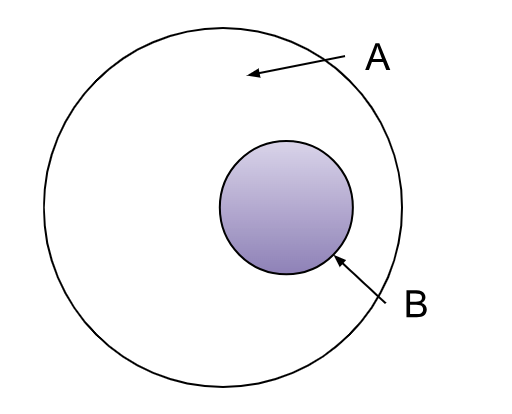0.1: Sets
- Page ID
- 131016
\( \newcommand{\vecs}[1]{\overset { \scriptstyle \rightharpoonup} {\mathbf{#1}} } \)
\( \newcommand{\vecd}[1]{\overset{-\!-\!\rightharpoonup}{\vphantom{a}\smash {#1}}} \)
\( \newcommand{\dsum}{\displaystyle\sum\limits} \)
\( \newcommand{\dint}{\displaystyle\int\limits} \)
\( \newcommand{\dlim}{\displaystyle\lim\limits} \)
\( \newcommand{\id}{\mathrm{id}}\) \( \newcommand{\Span}{\mathrm{span}}\)
( \newcommand{\kernel}{\mathrm{null}\,}\) \( \newcommand{\range}{\mathrm{range}\,}\)
\( \newcommand{\RealPart}{\mathrm{Re}}\) \( \newcommand{\ImaginaryPart}{\mathrm{Im}}\)
\( \newcommand{\Argument}{\mathrm{Arg}}\) \( \newcommand{\norm}[1]{\| #1 \|}\)
\( \newcommand{\inner}[2]{\langle #1, #2 \rangle}\)
\( \newcommand{\Span}{\mathrm{span}}\)
\( \newcommand{\id}{\mathrm{id}}\)
\( \newcommand{\Span}{\mathrm{span}}\)
\( \newcommand{\kernel}{\mathrm{null}\,}\)
\( \newcommand{\range}{\mathrm{range}\,}\)
\( \newcommand{\RealPart}{\mathrm{Re}}\)
\( \newcommand{\ImaginaryPart}{\mathrm{Im}}\)
\( \newcommand{\Argument}{\mathrm{Arg}}\)
\( \newcommand{\norm}[1]{\| #1 \|}\)
\( \newcommand{\inner}[2]{\langle #1, #2 \rangle}\)
\( \newcommand{\Span}{\mathrm{span}}\) \( \newcommand{\AA}{\unicode[.8,0]{x212B}}\)
\( \newcommand{\vectorA}[1]{\vec{#1}} % arrow\)
\( \newcommand{\vectorAt}[1]{\vec{\text{#1}}} % arrow\)
\( \newcommand{\vectorB}[1]{\overset { \scriptstyle \rightharpoonup} {\mathbf{#1}} } \)
\( \newcommand{\vectorC}[1]{\textbf{#1}} \)
\( \newcommand{\vectorD}[1]{\overrightarrow{#1}} \)
\( \newcommand{\vectorDt}[1]{\overrightarrow{\text{#1}}} \)
\( \newcommand{\vectE}[1]{\overset{-\!-\!\rightharpoonup}{\vphantom{a}\smash{\mathbf {#1}}}} \)
\( \newcommand{\vecs}[1]{\overset { \scriptstyle \rightharpoonup} {\mathbf{#1}} } \)
\( \newcommand{\vecd}[1]{\overset{-\!-\!\rightharpoonup}{\vphantom{a}\smash {#1}}} \)
\(\newcommand{\avec}{\mathbf a}\) \(\newcommand{\bvec}{\mathbf b}\) \(\newcommand{\cvec}{\mathbf c}\) \(\newcommand{\dvec}{\mathbf d}\) \(\newcommand{\dtil}{\widetilde{\mathbf d}}\) \(\newcommand{\evec}{\mathbf e}\) \(\newcommand{\fvec}{\mathbf f}\) \(\newcommand{\nvec}{\mathbf n}\) \(\newcommand{\pvec}{\mathbf p}\) \(\newcommand{\qvec}{\mathbf q}\) \(\newcommand{\svec}{\mathbf s}\) \(\newcommand{\tvec}{\mathbf t}\) \(\newcommand{\uvec}{\mathbf u}\) \(\newcommand{\vvec}{\mathbf v}\) \(\newcommand{\wvec}{\mathbf w}\) \(\newcommand{\xvec}{\mathbf x}\) \(\newcommand{\yvec}{\mathbf y}\) \(\newcommand{\zvec}{\mathbf z}\) \(\newcommand{\rvec}{\mathbf r}\) \(\newcommand{\mvec}{\mathbf m}\) \(\newcommand{\zerovec}{\mathbf 0}\) \(\newcommand{\onevec}{\mathbf 1}\) \(\newcommand{\real}{\mathbb R}\) \(\newcommand{\twovec}[2]{\left[\begin{array}{r}#1 \\ #2 \end{array}\right]}\) \(\newcommand{\ctwovec}[2]{\left[\begin{array}{c}#1 \\ #2 \end{array}\right]}\) \(\newcommand{\threevec}[3]{\left[\begin{array}{r}#1 \\ #2 \\ #3 \end{array}\right]}\) \(\newcommand{\cthreevec}[3]{\left[\begin{array}{c}#1 \\ #2 \\ #3 \end{array}\right]}\) \(\newcommand{\fourvec}[4]{\left[\begin{array}{r}#1 \\ #2 \\ #3 \\ #4 \end{array}\right]}\) \(\newcommand{\cfourvec}[4]{\left[\begin{array}{c}#1 \\ #2 \\ #3 \\ #4 \end{array}\right]}\) \(\newcommand{\fivevec}[5]{\left[\begin{array}{r}#1 \\ #2 \\ #3 \\ #4 \\ #5 \\ \end{array}\right]}\) \(\newcommand{\cfivevec}[5]{\left[\begin{array}{c}#1 \\ #2 \\ #3 \\ #4 \\ #5 \\ \end{array}\right]}\) \(\newcommand{\mattwo}[4]{\left[\begin{array}{rr}#1 \amp #2 \\ #3 \amp #4 \\ \end{array}\right]}\) \(\newcommand{\laspan}[1]{\text{Span}\{#1\}}\) \(\newcommand{\bcal}{\cal B}\) \(\newcommand{\ccal}{\cal C}\) \(\newcommand{\scal}{\cal S}\) \(\newcommand{\wcal}{\cal W}\) \(\newcommand{\ecal}{\cal E}\) \(\newcommand{\coords}[2]{\left\{#1\right\}_{#2}}\) \(\newcommand{\gray}[1]{\color{gray}{#1}}\) \(\newcommand{\lgray}[1]{\color{lightgray}{#1}}\) \(\newcommand{\rank}{\operatorname{rank}}\) \(\newcommand{\row}{\text{Row}}\) \(\newcommand{\col}{\text{Col}}\) \(\renewcommand{\row}{\text{Row}}\) \(\newcommand{\nul}{\text{Nul}}\) \(\newcommand{\var}{\text{Var}}\) \(\newcommand{\corr}{\text{corr}}\) \(\newcommand{\len}[1]{\left|#1\right|}\) \(\newcommand{\bbar}{\overline{\bvec}}\) \(\newcommand{\bhat}{\widehat{\bvec}}\) \(\newcommand{\bperp}{\bvec^\perp}\) \(\newcommand{\xhat}{\widehat{\xvec}}\) \(\newcommand{\vhat}{\widehat{\vvec}}\) \(\newcommand{\uhat}{\widehat{\uvec}}\) \(\newcommand{\what}{\widehat{\wvec}}\) \(\newcommand{\Sighat}{\widehat{\Sigma}}\) \(\newcommand{\lt}{<}\) \(\newcommand{\gt}{>}\) \(\newcommand{\amp}{&}\) \(\definecolor{fillinmathshade}{gray}{0.9}\)Sets
-
Sets are collections of objects,
-
Sets are normally denoted by capital letters.
-
Elements are denoted by lower-case letters.
-
Subsets:
-
Every element of B is an element of A, written as \( B\subset A.\)
-
\(B=\{a \in A:\) …..condition on okay!.
-
Trivial subsets of \(A\) are \(A\) and \(\emptyset \) (empty set).
-
-
How do we test if an element belongs to a set?
Example \(\PageIndex{1}\)
\(M_{22}(\mathbb{R}):=\) set of all 2 x 2 matrices with real numbers, where \(\mathbb{R}:=\) set of all real numbers.
Let \(A=\big{\{}\begin{bmatrix}x\end{bmatrix} \in M_{22}(\mathbb{R})|\begin{bmatrix}x\end{bmatrix}\begin{bmatrix}1 &1\\
0 &1\end{bmatrix}=\begin{bmatrix}1 &1\\
0 &1\end{bmatrix}\begin{bmatrix}x\end{bmatrix}\big{\}}\).
Determine whether the following entries belong to \(A\).
-
\(\begin{bmatrix}1 & 0\\
0 & 0\end{bmatrix}\) does not belong to \(A\).
- Answer
-
\(\begin{bmatrix}1 & 0\\
0 & 0\end{bmatrix} \cdot \begin{bmatrix}1 &1\\
0 &1\end{bmatrix}=\begin{bmatrix}1 &1\\
0 &0\end{bmatrix}\) and\(\begin{bmatrix}1 &1\\
0 &1\end{bmatrix} \cdot \begin{bmatrix}1 & 0\\
0 & 0\end{bmatrix}=\begin{bmatrix}1 &0\\
0 &0\end{bmatrix}\)Since \(\begin{bmatrix}1 &1\\
0 &0\end{bmatrix} \ne \begin{bmatrix}1 &0\\
0 &0\end{bmatrix}\), \(\begin{bmatrix}1 & 0\\
0 & 0\end{bmatrix} \notin A\).◻
-
\(\begin{bmatrix}0 & 1\\
0 & 0\end{bmatrix}\) does belong to \(A\).
- Answer
-
\(\begin{bmatrix}0 & 1\\
0 & 0\end{bmatrix} \cdot \begin{bmatrix}1 &1\\
0 &1\end{bmatrix}=\begin{bmatrix}0 &1
0 &0\end{bmatrix}\)\(\begin{bmatrix}1 &1\\
0 &1\end{bmatrix} \cdot \begin{bmatrix}0 & 1\\
0 & 0\end{bmatrix}=\begin{bmatrix}0 &1\\
0 &0\end{bmatrix}\)Since \(\begin{bmatrix}0 &1\\
0 &0\end{bmatrix} = \begin{bmatrix}0 &1\\
0 &0\end{bmatrix}\), \(\begin{bmatrix}1 & 0\\
0 & 0\end{bmatrix} \in A\).◻
-
\(\begin{bmatrix}0 & 0\\
1 & 0\end{bmatrix}\) does not belong to \(A\).
- Answer
-
\(\begin{bmatrix}0 & 0\\
1 & 0\end{bmatrix} \cdot \begin{bmatrix}1 &1\\
0 &1\end{bmatrix}=\begin{bmatrix}0 &0\\
1 &1\end{bmatrix}\)\(\begin{bmatrix}1 &1\\
0 &1\end{bmatrix} \cdot \begin{bmatrix}0 & 0\\
1 & 0\end{bmatrix}=\begin{bmatrix}1 &0\\
1 &0\end{bmatrix}\)Since \(\begin{bmatrix}0 &0\\
1 &1\end{bmatrix} \ne \begin{bmatrix}1 &0\\
1 &0\end{bmatrix}\), \(\begin{bmatrix}0 & 0\\
1 & 0\end{bmatrix} \notin A\).◻
-
\(\begin{bmatrix}0 & 0\\
0 & 1\end{bmatrix}\) does not belong to \(A\).
- Answer
-
\(\begin{bmatrix}0 & 0\\
0 & 1\end{bmatrix} \cdot \begin{bmatrix}1 &1\\
0 &1\end{bmatrix}=\begin{bmatrix}0 &0\\
0 &1\end{bmatrix}\)\(\begin{bmatrix}1 &1\\
0 &1\end{bmatrix} \cdot \begin{bmatrix}0 & 0\\
0 & 1\end{bmatrix}=\begin{bmatrix}0 &1\\
0 &1\end{bmatrix}\)Since \(\begin{bmatrix}0 &0\\
0 &1\end{bmatrix} \ne \begin{bmatrix}0 &1\\
0 &1\end{bmatrix}\), \(\begin{bmatrix}0 & 0\\
0 & 1\end{bmatrix} \notin A\).◻
-
\(\begin{bmatrix}0 & 0\\
0 & 0\end{bmatrix}\). does belong to \(A\).
Solution
This one is obviously true, thus \(\begin{bmatrix}0 & 0\\
0 & 0\end{bmatrix} \in A\).
-
\(\cup\) or / union
-
\(\cap\) and / intersection
-
\(\{\}^c\) complement of a set (aka \(\{\}^{'}\)).
-
\(A \backslash B\) is equivalent to \(A \cap B^{'}\).
-
\(\mathbb{Z}:=\) set of all integers \(=\{\ldots,-2,-1,0,1,2,\ldots\}\). A countable set.
-
\(\mathbb{Q}:=\) set of all rational numbers \(=\{\frac{a}{b}: a,b \in \mathbb{Z}, b \ne 0 \}\). A countable set.
-
\(\mathbb{Q}^c:=\) set of all irrational numbers \(=\{\pm e, \pm \pi, \pm \sqrt{2}, \ldots\}\). Not a countable set.
-
\(\mathbb{R}:=\) set of all real numbers \(=\mathbb{Q} \cup \mathbb{Q}^c\). Note \(\mathbb{Q} \cap \mathbb{Q}^c=\emptyset\). Not a countable set.
-
\(\mathbb{C}:=\) set of all complex numbers.
-
\(M_{mn}(\mathbb{R}):=\) set of all \(m \times n\) matrices over real numbers.
-
\(M_{mn}(\mathbb{C}):=\) set of all \(m \times n\) matrices over complex numbers.
-
The cardinality of a set \(A\) is written as \(|A|\).
\(\mathbb{N} \subseteq \mathbb{Z} \subseteq \mathbb{Q} \subseteq \mathbb{R} \subseteq \mathbb{C}\).
Example \(\PageIndex{3}\)
Let \(A=\{1,2,3,5\}\). Therefore \(|A|=4\). In this case, \(A\) is called a finite set.


